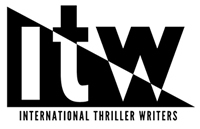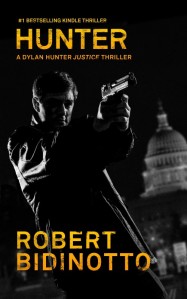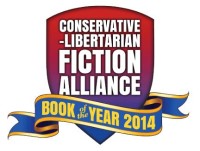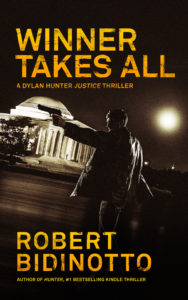A common lament of authors is: How do I promote my books? I’ve tried to present a host of time-tested ideas in this blog.
Author business cards constitute one of the cheapest, easiest methods to build a readership and increase sales. I know that I’ve sold hundreds of books through the use of my HUNTER business card.
Before I begin, let me first give a tip of the hat to Robin Sullivan — wife and business partner of bestselling fantasy author Michael J. Sullivan — for providing 90% of the ideas and information in this post.
Robin used to maintain an invaluable website/blog, “Write To Publish,” which, sadly, has been defunct for some years. One of her most useful posts for me was “Author’s Business Cards…Get Them…Use Them.” Precisely because her information is so valuable, it deserves a new lease on life. So here I am, snitching it shamelessly yet publicly, giving full credit to Robin. If you read her article, then you won’t have to read this one.
Here, though, I want to indicate how I’ve adapted her methods for my own use.
In terms of bang-for-the-buck, I can’t think of many methods of advertising your books that generate a better return than business cards. For about an hour of time, plus the price of a restaurant meal, you can produce an advertising product that can generate thousands of dollars in sales and a host of fans.
First, like Robin, let me recommend as a source for inexpensive business cards GotPrint.com. Just today I designed and ordered 1,000 new cards for the forthcoming release of BAD DEEDS. These one thousand cards — two-sided, full-color, UV coated, on thick glossy stock — cost only $19.00. You read that correctly. I splurged for “rush” production, and spent $26.35. You have a variety of shipping options. Mine cost me an additional $14.63. Grand total: $40.98. And the quality is fabulous.
On their site, you can start with a blank card, with tabs for front and back views. Or you can use one of their templates. I didn’t bother with the templates, because I knew what I wanted. Here is the front view of the business card (click for a larger view).
As you can see, I used the cover of HUNTER as the eye-grabbing basis for the card. You can upload book covers or any other image into the blank template on the GotPrint site, then manipulate it to fit the space. The template on the screen was horizontally aligned, and the book cover is of course vertical. Manipulating the image around took a bit of getting used to, but there are good instructions.
Next, beneath the cover, I inserted a curiosity-arousing “teaser,” consisting of three questions. I positioned them on three lines, to look reasonably aligned. For the font, I chose an italicized Verdana, in all caps, but in a dark gray shade. That was to offset the website link at the very bottom, which I didn’t italicize, and which is in black. It’s very important to make your main link stand out, easy to find and read.
For the back, I wanted to provide a lot of information in an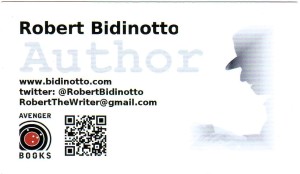 attractive horizontal display. As you can see, it consists of a number of elements. I selected a “writerly” photo and positioned it on the right-hand third of the card; it’s just a bit bigger than postage-stamp size. The left-hand two-thirds of the card provide the info. So that the card wouldn’t look too “busy,” I stuck with the Verdana font, with one exception: the word “Author.” I thought that since the photo shows me at a keyboard, it would be cool to use Courier font. I selected a light grayscale color, to blend into the gray image of the photo to its right. Then I provided three lines of contact information. Finally, bottom left, I put in my Avenger Books publishing logo, and a QR code. That code, when scanned by a smartphone, will take the reader right to the HUNTER product page on Amazon.
attractive horizontal display. As you can see, it consists of a number of elements. I selected a “writerly” photo and positioned it on the right-hand third of the card; it’s just a bit bigger than postage-stamp size. The left-hand two-thirds of the card provide the info. So that the card wouldn’t look too “busy,” I stuck with the Verdana font, with one exception: the word “Author.” I thought that since the photo shows me at a keyboard, it would be cool to use Courier font. I selected a light grayscale color, to blend into the gray image of the photo to its right. Then I provided three lines of contact information. Finally, bottom left, I put in my Avenger Books publishing logo, and a QR code. That code, when scanned by a smartphone, will take the reader right to the HUNTER product page on Amazon.
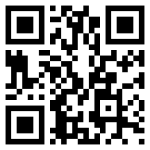 What are QR codes, and where can you get them? Once again, Robin Sullivan explains. You can turn any URL link into a graphic QR code, download it, and use it on anything from business cards to T-shirts to billboards. Just go here to generate your own. The one shown here is for this blog.
What are QR codes, and where can you get them? Once again, Robin Sullivan explains. You can turn any URL link into a graphic QR code, download it, and use it on anything from business cards to T-shirts to billboards. Just go here to generate your own. The one shown here is for this blog.
Now, how do you use business cards? Robin offers a lot of tips. I’ve posted them on public bulletin boards in restaurants, shops, and post offices, and left small stacks (with permission, of course) in various retail shops, bookstores, libraries, and other places where readers might show up.
However, by far the best way to use them is person-to-person. Every time you meet someone new, they want to know what you do. “I’m an author,” you say, and hand them your card. If you have a spiffy-looking book cover, your card will impress them and very likely generate questions.
But you don’t have to wait around to encounter strangers. You are constantly running into strangers: store clerks, waiters and waitresses, barbers and hair stylists, people sitting next to you in coffee shops, the clerk at the post office window. You can initiate a conversation, quite naturally. For example, if I’ve just had someone perform a service for me, like a waitress or clerk, I often say something like:
Me: “Thanks so much for the help . . . By the way, [Name], are you a reader?”
Them: “A reader? You mean magazines?”
Me: “Do you like to read books?”
Now, at this point, you’ll get a quick sense of the person’s potential as a reader of your book. If he or she isn’t much of a reader, just let it go.
On the other hand, if the person says, “Oh, sure. I read a lot,” then you have an opening for your next question:
Me: “You looked like a reader to me. Tell me: What do you read when you read?”
Then shut up and listen. If they indicate interests well outside of the type and genre of your own book, you probably don’t have the basis to give him or her your card. You can follow up, of course, asking if the person reads in your general category. In my case, I’m looking for (a) readers of (b) thrillers, mysteries, suspense, or romance. Because my novels also explore serious political, psychological, and philosophical issues, there’s a chance that anyone interested in those things may also find my books interesting.
If you see no interests even remotely related to your book, you can let it go, saying, “Well, that’s interesting.” If they pursue it and ask you why you inquired, you can then tell them you’re an author. And they may pursue it further, at which point you can give them a card.
Ideally, though, they’ll indicate some interest in an area related to your work. At that point, you can take out a card, hand it to them, and say:
Me: “Then you might find my latest book interesting.”
Them: (looking up from the card) “You wrote this?”
Me: “That’s right. [Now give them a one-or-two sentence generic summary.] It’s the first book in a suspense thriller series, featuring a journalist with a mysterious past. You say you like thrillers [mysteries, romances, whatever]. What are some of your favorite books and authors?”
That question will give you more information and possible bases for common interests and further conversation. In my case, if they happen to name one of my favorite authors, then we’re really off to the races. We can chat briefly about that, and I can then explain how my own work might be similar or different from those other works. It also gives me the opportunity to give just a bit more curiosity-inspiring info about the story. I usually wrap it up with something like this:
Me: “Well, it sounds to me as if my novel might be one you’d enjoy. You have my card; why don’t you look it up tonight on Amazon? Check out the description and the customer reviews, and see if it might be something you’d like. As you’ll see, my readers have been very kind to the book. Oh, by the way — do you prefer ebooks, print books, or audiobooks? . . . HUNTER is available in all three editions.”
And then I thank them for their time and interest. Simple, friendly conversation.
I have made a lot of sales that way. More importantly: I have also made a lot of good friends! What starts as passing conversation can sometimes blossom into enduring relationships.
All from an inexpensive little business card.
Try it. I think you’ll be pleased with the results.
Now, I eagerly await the receipt of my new batch of business cards, featuring this new cover. Talk about a conversation-starter, eh?

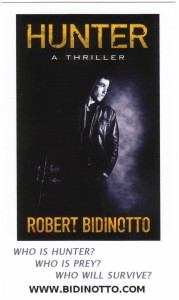

 Photo (c) by Debbie Scott
Photo (c) by Debbie Scott
